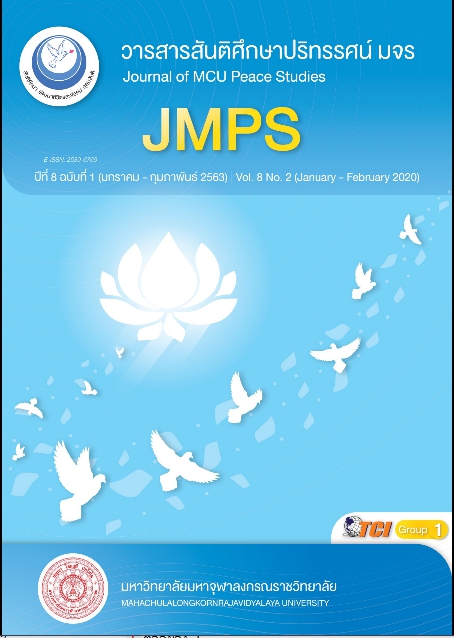การพัฒนาตัวแบบเชิงระบบ เพื่อการเรียนรู้และกลไกการเปลี่ยนผ่านการพัฒนา แผนแม่บทงานบริการวิชาการสำหรับสถาบันอุดมศึกษา: กรณีศึกษา คณะสิ่งแวดล้อมและทรัพยากรศาสตร์ มหาวิทยาลัยมหิดล
Main Article Content
บทคัดย่อ
การวิจัยนี้เป็นกรณีศึกษาเชิงคุณภาพได้นำเสนอตัวแบบเชิงระบบ (Systematic module) เพื่อเป็นเครื่องมือทางความคิดการยกระดับเรียนรู้ขององค์กร สู่การกำหนดกลไกการพัฒนาแผนแม่บทงานบริการวิชาการเชิงประจักษ์สำหรับสถาบันอุดมศึกษา หน่วยการศึกษากำหนดเป็นคณะสิ่งแวดล้อมและทรัพยากรศาสตร์ ซึ่งเป็นองค์กรกำกับภายใต้มหาวิทยาลัยมหิดล วิธีการศึกษาวิจัยเป็นลักษณะการประชุมเชิงปฏิบัติการอย่างมีส่วนร่วมและการสนทนากลุ่ม จากบุคลากรทุกระดับขององค์กร ผู้บริหาร ตัวแทนหัวหน้าหน่วยงาน อาจารย์และนักวิจัย ที่มีส่วนเกี่ยวข้องกับการขับเคลื่อนยุทธศาสตร์การบริการวิชาการขององค์กร ตัวแบบการเรียนรู้ ได้พัฒนาขึ้นในลักษณะแผนภาพการเรียนรู้วงจรระบบเชิงนามธรรม (Soft system archetype CLD) ด้วยการสนับสนุนจากโปรแกรม VENSIM® เพื่อบูรณการชุดข้อมูลทุติยภูมิ อาทิ พลวัตระบบแวดล้อมทางสังคม ข้อมูลด้านนโยบายและยุทธศาสตร์ชาติ แผนยุทธศาสตร์งานบริการวิชาการของสถาบันอุดมศึกษา และมิติการเรียนรู้ที่สำคัญเพื่อการบริการวิชาการจากผู้เข้าร่วมกิจกรรมการวิจัย ผลการศึกษาจากตัวแบบที่ได้พัฒนาขึ้น ได้แสดงถึงมิติความสัมพันธ์เชิงระบบและพฤติกรรมแรงขับเคลื่อนที่มีอิทธิพลการเรียนรู้ด้านองค์ประกอบหลักการบริหารขององค์กร ประกอบด้วย นโยบาย การบริการวิชาการ แผนปฏิบัติ การขับเคลื่อนสู่การปฏิบัติและการประเมินขององค์กร ตัวแบบระบบยังชี้ให้เห็นถึงปัจจัยสำคัญและเป็นกลไกการเปลี่ยนผ่าน (Key leverage mechanism) การบริหารจัดการองค์กรในมิติต่างๆ อาทิ การกำหนดทิศทาง เป้าหมายการกำหนดแผน กลยุทธ์ กระบวนการพัฒนาประสิทธิภาพและประสิทธิผล และการประเมินกิจกรรมการบริการวิชาการขององค์กร ทั้งนี้ ตัวแบบที่ได้พัฒนาขึ้นจากการศึกษา ถือว่าเป็นประโยชน์ต่อการยกระดับการเรียนรู้การพัฒนาแผนและแนวทางการบริหารจัดการของสถาบันอุดมศึกษา ภายใต้พลวัตสังคมและเป้าหมายการเข้าสู่สังคมความรู้ในศตวรรษที่ 21
Article Details
ทัศนะและความคิดเห็นที่ปรากฏในบทความในวารสาร ถือเป็นความรับผิดชอบของผู้เขียนบทความนั้น และไม่ถือเป็นทัศนะและความรับผิดชอบของกองบรรณาธิการ ยินยอมว่าบทความเป็นลิขสิทธิ์ของวารสาร
เอกสารอ้างอิง
Argyris, C. (1999). On Organization Learning. Oxford: Blackwell.
Beer, S. (1979). The Heart of the Enterprise. Chichester: John Wiley & Sons.
Beer, S. (1981). The Brain of the Firm, Chichester: John Wiley & Sons.
Benson, T., & Marlin, S. (2017). System Thinking for Policy Making: The Potential of System Analysis for Addressing Global Policy Challenges in the 21st Century: The Habit-Forming Guide to Becoming a Systems Thinker. PA: Systems Thinking Group, Inc.
Capra, F. (1982). The Turning Point. New York: Simon & Schuster.
Checkland, P.B. (1981). Systems Thinking, Systems Practice. Chichester: John Wiley and Sons.
Chofreh, A.G. et al. (2016). A master plan for the implementation of sustainable enterprise resource planning systems (part I): Concept and methodology. Journal of Cleaner Production, 136, 176-182.
Chofreh, A.G., Goni, F.A. & Klemes, J.J. (2017). Development of a roadmap for sustainable enterprise resource planning systems implementation (part II). Journal of Cleaner Production, 166, 425-437.
Chofreh, A.G., Goni, F.A. & Klemes, J.J. (2018). A roadmap for sustainable enterprise resource planning systems implementation (part III). Journal of Cleaner Production, 174, 1325-1337.
Decharin, P. (2008). Organization Improvement Toolkits Section 2: Strategic Planning. Bangkok: Vision Print and Media Co., Ltd.
Forrester, J.W. (1961). Industrial Dynamics, (2nd Edition). MA: Pegasus Communications.
Hock, D. (1999). Birth of the Chaordic Age. San Francisco, CA: Berrett-Koehler.
Holmlund, M., Kowalkowski, C. & Biggemann, S. (2016). Organizational behavior in innovation, marketing, and purchasing in business service context-An agenda for academic inquiry. Journal of Business Research, 69, 2457-2462.
Morecroft J. (2010). Romeo and Juliet in Brazil: Use of Metaphorical Models for Feedback Systems Thinking, chapter 6 in Tracing Connections, Voices of Systems Thinkers. (Editors Joy Richmond, Kathy Richmond, Joanne Egner & Lees Stuntz, dedicated to the memory of Barry Richmond), NH: isee systems.
Jackson, M.C. (1991). Systems Methodology for the Management Sciences. New York: Plenum. Phoomravi, N. (2010). Participation processes in preparing the community master plan in Tambon Wangtakor, Amphoe Langsuan, Changwat Chumporn. Parichart Journal, 23(2), 81-100.
Richardson, G.P. (1991). Feedback Thought in Social Science and Systems Theory, Philadelphia: University of Pennsylvania Press.
Sadeghnezhad, M., Nabavi, F.H., Najafi, F. & Kareshki, H. (2018). Mutual benefits in academic – service partnership: An integrative review. Nurse Education Today, 68, 78-85.
Schwartz, P. (2003). Inevitable Surprises: Thinking Ahead in a Time of Turbulence. New York: Gotham Books.
Senge, P.M. (1996). The Fifth Discipline Fieldbook: Strategies and Tools for Building a Learning Organization. London: Nicholas Brealey.
Thaithong, N. (2011). Creation of master plan for Rajabhat University’s information technology. Industrial Technology Lampang Rajabhat University Journal, 4, 32-47.
UNESCO. (1998a, 1998b). Framework for Priority Action for Change and Development in Higher Education. Site in World Conference on Higher Education (WCHE, 1998b). Paris: UNESCO.
Ulrich, W. (1983). Critical Heuristics of Social Planning: A New Approach to Practical Philosophy. Bern: Haupt
Wheatley, M.J. (1999). Leadership and the New Science: Discovering Order in a Chaotic World. San Francisco: Berrett-Koehler Publishers.


